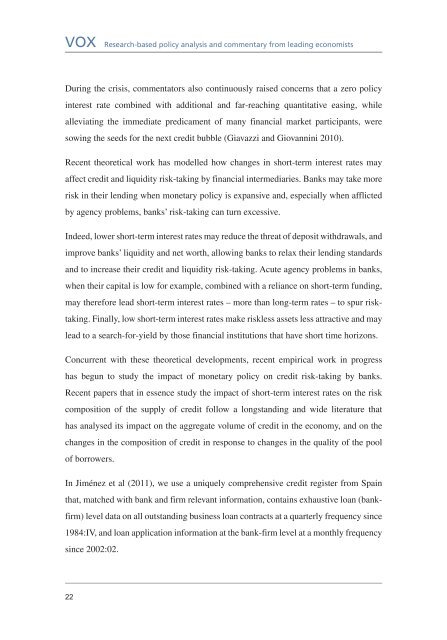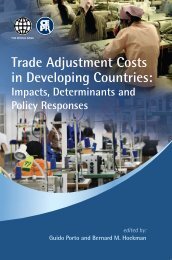You also want an ePaper? Increase the reach of your titles
YUMPU automatically turns print PDFs into web optimized ePapers that Google loves.
VOX Research-based policy analysis and commentary from leading economists<br />
During the crisis, commentators also continuously raised concerns that a zero policy<br />
interest rate combined with additional and far-reaching quantitative easing, while<br />
alleviating the immediate predicament of many financial market participants, were<br />
sowing the seeds for the next credit bubble (Giavazzi and Giovannini 2010).<br />
Recent theoretical work has modelled how changes in short-term interest rates may<br />
affect credit and liquidity risk-taking <strong>by</strong> financial intermediaries. Banks may take more<br />
risk in their lending when monetary policy is expansive and, especially when afflicted<br />
<strong>by</strong> agency problems, banks’ risk-taking can turn excessive.<br />
Indeed, lower short-term interest rates may reduce the threat of deposit withdrawals, and<br />
improve banks’ liquidity and net worth, allowing banks to relax their lending standards<br />
and to increase their credit and liquidity risk-taking. Acute agency problems in banks,<br />
when their capital is low for example, combined with a reliance on short-term funding,<br />
may therefore lead short-term interest rates – more than long-term rates – to spur risktaking.<br />
Finally, low short-term interest rates make riskless assets less attractive and may<br />
lead to a search-for-yield <strong>by</strong> those financial institutions that have short time horizons.<br />
Concurrent with these theoretical developments, recent empirical work in progress<br />
has begun to study the impact of monetary policy on credit risk-taking <strong>by</strong> banks.<br />
Recent papers that in essence study the impact of short-term interest rates on the risk<br />
composition of the supply of credit follow a longstanding and wide literature that<br />
has analysed its impact on the aggregate volume of credit in the economy, and on the<br />
changes in the composition of credit in response to changes in the quality of the pool<br />
of borrowers.<br />
In Jiménez et al (2011), we use a uniquely comprehensive credit register from Spain<br />
that, matched with bank and firm relevant information, contains exhaustive loan (bankfirm)<br />
level data on all outstanding business loan contracts at a quarterly frequency since<br />
1984:IV, and loan application information at the bank-firm level at a monthly frequency<br />
since 2002:02.<br />
22














